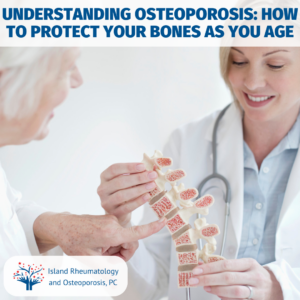Understanding Osteoporosis: How to Protect Your Bones as You Age
 Osteoporosis is a common condition that weakens bones, making them more prone to fractures. While it often affects older adults, it is not an inevitable part of aging. Understanding the risk factors, prevention strategies, and management options can help protect your bones and maintain your quality of life.
Osteoporosis is a common condition that weakens bones, making them more prone to fractures. While it often affects older adults, it is not an inevitable part of aging. Understanding the risk factors, prevention strategies, and management options can help protect your bones and maintain your quality of life.
What Is Osteoporosis?
Osteoporosis occurs when bone density and strength decrease due to an imbalance in the natural process of bone remodeling. As we age, the body may resorb old bone faster than it can create new bone, leading to weaker bones that are more susceptible to fractures, particularly in the hip, spine, and wrist.
Risk Factors for Osteoporosis
Several factors increase the likelihood of developing osteoporosis:
-
Unchangeable factors: Being female, advanced age, a family history of osteoporosis or fractures, and a smaller body frame.
-
Hormonal changes: Low levels of estrogen in women (e.g., after menopause) or testosterone in men.
-
Lifestyle choices: Smoking, excessive alcohol consumption, physical inactivity, and poor nutrition (low calcium or vitamin D intake).
-
Medical conditions: Chronic illnesses like rheumatoid arthritis or kidney disease and long-term use of medications like corticosteroids.
How to Protect Your Bones
Protecting your bones involves a combination of lifestyle changes and medical interventions. Here are some key strategies:
1. Nutrition
-
Calcium: Essential for bone health. Adults aged 50 and older should aim for 1,200 mg of calcium daily through dairy products, leafy greens, or supplements if necessary.
-
Vitamin D: Helps the body absorb calcium. Sun exposure and foods like fortified milk or fatty fish can provide sufficient vitamin D. Supplements may be needed for those with low levels.
2. Exercise
Weight-bearing and muscle-strengthening exercises are critical for maintaining bone density. Activities like walking, dancing, or resistance training stimulate bone remodeling. Balance exercises such as tai chi can also reduce fall risks.
3. Avoid Harmful Habits
Smoking and excessive alcohol consumption weaken bones over time. Quitting smoking and limiting alcohol intake to moderate levels can significantly reduce your risk.
4. Fall Prevention
Falls are a major cause of fractures in older adults. To minimize risks:
-
Ensure your home is free from tripping hazards.
-
Use assistive devices if necessary.
-
Engage in exercises that improve balance and coordination.
5. Medical Interventions
If you’re at high risk for osteoporosis or already have the condition:
-
Discuss medications with your doctor that can slow bone loss or promote bone formation.
-
Regularly monitor your bone density through tests like a DEXA scan.
The Importance of Early Action
Osteoporosis often progresses silently until a fracture occurs. Early prevention is key—building strong bones during youth reduces the risk later in life. For older adults, proactive measures such as proper nutrition, exercise, and medical care can slow disease progression and prevent complications.
By understanding osteoporosis and taking steps to protect your bones, you can maintain mobility and independence as you age. Consult with healthcare providers to assess your risk factors and develop a personalized plan for optimal bone health.
Take the First Step Towards Stronger Bones Today
If you are concerned about osteoporosis or want to learn more about how to protect your bone health, contact Island Rheumatology and Osteoporosis PC today. Our team of experienced healthcare professionals is dedicated to providing comprehensive care and guidance tailored to your needs. Schedule a consultation to discuss your risk factors, explore prevention strategies, and develop a personalized plan to ensure strong, healthy bones for years to come. Call us now to take the first step towards a healthier, more active life.

